Electric cars have come a long way over the past few years and improvements across the board mean they’re a more viable ownership option than ever before.
But which are the best electric cars you can buy today? Well, some are better at certain things than others, so we’ve organised the cars in this list to highlight exactly what they’re best at.
For example, some electric cars are better at delivering a long range, while others are best for practicality, driver appeal, or value for money.
Related articles
- The best electric SUVs – driven and ranked
- The best cheap electric cars you would actually want to own
- 2024’s best MPVs and people carriers – driven and tested
- 2024’s best small SUVs – driven and tested
- The best hybrid SUVs – driven and ranked
But don’t panic: whether you’re looking for the most practical EV or one loaded with enough tech to fill a branch of Currys, we’ve got you covered.
Each car on this list has been selected by a judging panel of Autocar journalists for its prowess in a specific area. We will explain what makes a good showing in each class and why each EV we’ve picked deserves its place.
And if you’re still not convinced by any car on this list, check out our comprehensive guide to all the new cars coming in 2024. It’s an especially big year for new electric cars, so you’re sure to find something you’re interested in.
So here are the best electric cars on sale right now.
1. Cupra Born
 Pros Well set-up chassis with good ride-and-handling balanceRear-drive dynamicsClassy interior Cons Stability control can be too eager to intervenePoor infotainmentExpensive
Pros Well set-up chassis with good ride-and-handling balanceRear-drive dynamicsClassy interior Cons Stability control can be too eager to intervenePoor infotainmentExpensive
Best for: fun factor
For a couple of years now, Autocar has conducted an annual test of the best-handling, most fun electric cars on sale, and the Cupra Born is the reigning champion, beating rivals such as the MG 4 XPower and Abarth 500e.
The Born sits at a compelling nexus of size and usability, weight and power, real-world range and price.
It has enough power to keep you interested but doesn’t seem excessive for the road or to compromise its efficiency in quicker motoring. It has an engaging, balanced, rear-driven chassis and some precision and purpose to its body control, but it also includes four usable seats and a decent boot.
The Cupra Born will also cover 220 real-world miles on a charge, which should be enough to get you to and from your favourite road, but it also has the personality and poise to make the trip worthwhile.
There’s a completeness to the Born as a package that makes it the ideal affordable EV for interested drivers to take their first steps into zero-emissions motoring. Perhaps not by chance, it feels more like a Volkswagen Golf GTI for the electric age than anything that Volkswagen itself is making right now.
Plus, Cupra has also just introduced the Cupra Born VZ: a hot hatch version, with 322bhp and 402lb ft. It’ll hit 0-62mph in 5.7sec, which is faster than the standard car by over a second.
Read our Cupra Born review
Save money on a new Cupra Born with WhatCar?
Finance this car with Drivenfi
Latest Reviews
Mercedes-AMG GT
Mercedes-AMG GT
Audi A5 and S5 review
Audi A5 and S5 review
Kia Xceed
Kia Xceed
Porsche Panamera
Porsche Panamera
Mercedes-AMG SL 63 E Performance review
Mercedes-AMG SL 63 E Performance review
Read our review
Car review
Cupra Born
Cupra’s first EV looks rather like a Volkswagen ID 3. Is the difference in the driving?
Read our review
2. Hyundai Ioniq 5 N
![]() Pros Terrifically adjustable handlingExploitable drive modesStrong straight-line performance Cons Not the most efficient EV (perhaps inevitably)Quite largeWeighs 2.2 tonnes
Pros Terrifically adjustable handlingExploitable drive modesStrong straight-line performance Cons Not the most efficient EV (perhaps inevitably)Quite largeWeighs 2.2 tonnes
Best for: sports car thrills
The Ioniq 5 N takes the brand’s electric crossover and sends it into electric sports car territory.
Utilising a dual-motor set-up, the Ioniq 5 N produces 641bhp and 549lb ft, hitting 0-62mph in a staggeringly fast 3.4sec. Hyundai claims it will do 278 miles on a charge thanks to an 89kWh battery.
While it might feel heavier and much bigger than a traditional sports car, you can make it sound and feel like one.
It’s got an inbuilt sound generator so drivers can select several different ‘engine’ notes, working in tandem with synthetic gear shifts.
A bit silly? Maybe, but it’s more convincing than any other high-performance EV we’ve tested in terms of bridging the gap between piston power and electric.
A landmark car? We think so, and a genuine driver’s car at that.
Read our Hyundai Ioniq 5 N review
Save money on a new Hyundai Ioniq 5 with WhatCar?
Finance this car with Drivenfi
3. Volkswagen ID 7
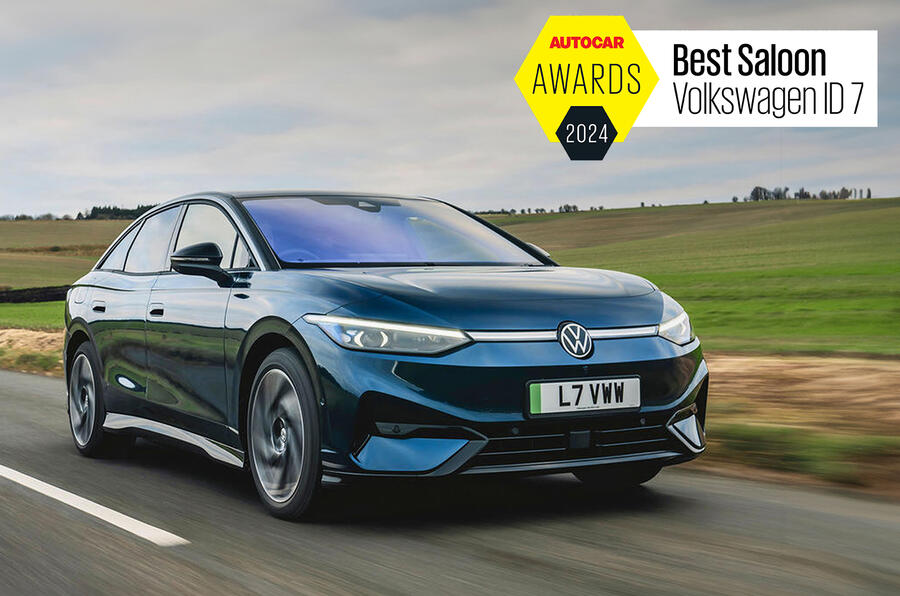 Pros The finest-riding electric car of any stripe at this price pointExtremely practicalTidy handling and such easy drivability are old-school VW Cons Infotainment controls are improved but still frustrate at timesNot the most inspiring product in terms of subjective appeal
Pros The finest-riding electric car of any stripe at this price pointExtremely practicalTidy handling and such easy drivability are old-school VW Cons Infotainment controls are improved but still frustrate at timesNot the most inspiring product in terms of subjective appeal
Best for: family appeal
There’s a lot to like about the Volkswagen ID 7, the German firm’s first electric saloon (which also comes as an estate).
A good choice for drivers looking to drive longer distances, the ID 7 comes as standard with a single motor set-up, producing 282bhp and 402lb ft. Longer-range cars are equipped with an 86kWh battery that offers a range surpassing 400 miles, with maximum charging speeds of 200kW.
The ID 7 drives brilliantly for such a large, heavy car. It’s not quite as sporty as a Tesla Model 3 or a BMW i4, but the ID 7 is very well-rounded. It feels agile, offers more than enough poke and grips well in the corners.
As for space, the ID 7, possesses 532 litres of boot space and limo-like rear space. It really is best-in-class in this respect, and the whole family will be comfortable.
Many of Volkswagen’s EVs have previously come under fire for poor material quality, but the ID 7 comes close to addressing most of these concerns, although the infotainment is still frustrating to use and there is still a distinct lack of material richness possessed by other premium options.
Read our Volkswagen ID 7 review
Save money on a new Volkswagen ID 7 with WhatCar?
Finance this car with Drivenfi
4. Porsche Taycan
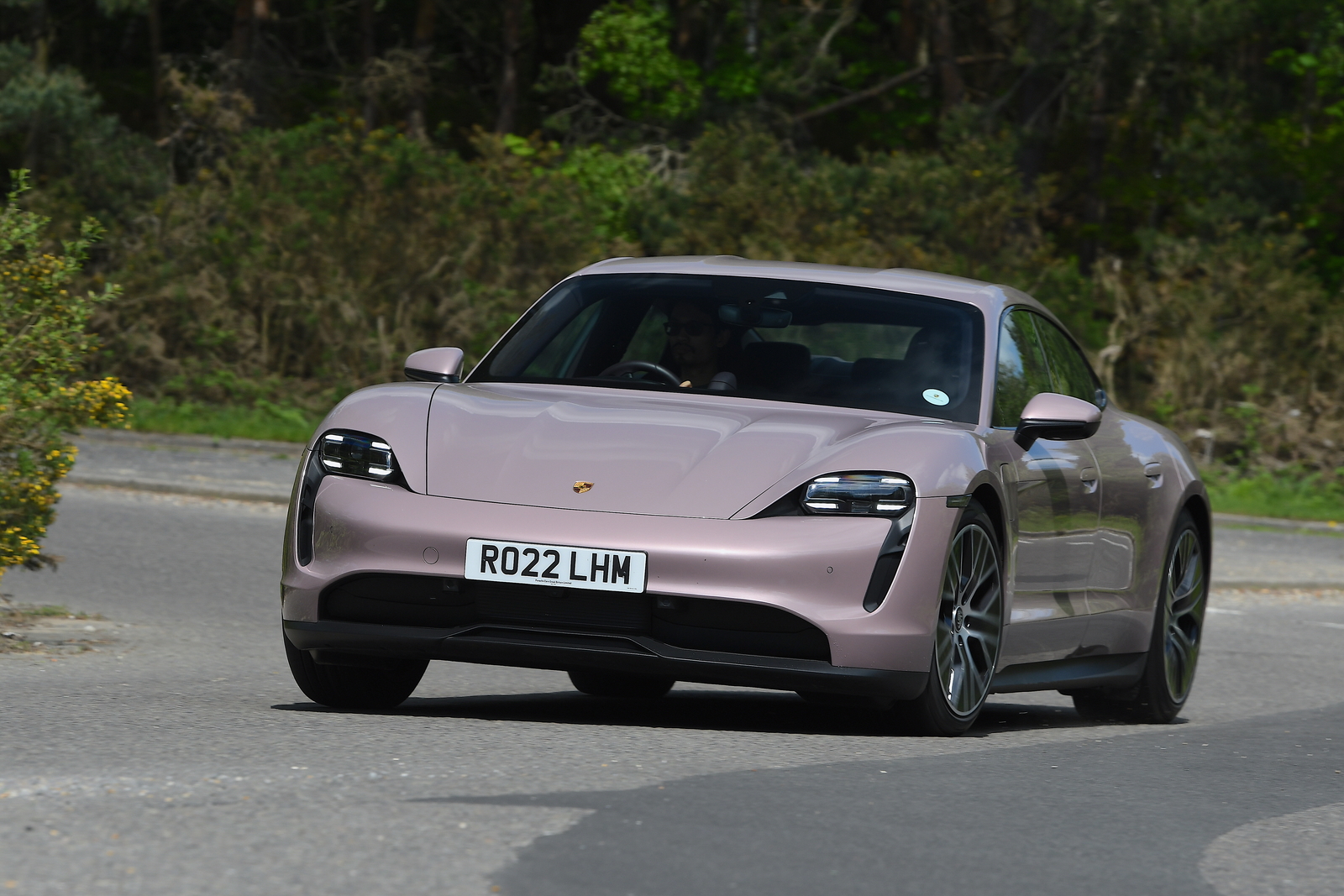 Pros Effortless agilityWide selection of bodystylesBig range Cons ExpensiveSecond-row seating is tight
Pros Effortless agilityWide selection of bodystylesBig range Cons ExpensiveSecond-row seating is tight
Best for: charging speed, handling
Porsche really stole a march on the rest of the luxury car industry when it introduced the Taycan electric saloon.
The first Taycan arrived in 2019, and through that time it was a truly standout car for its handling appeal, driver engagement and its DC rapid-charging speed. The best news is there’s a new Taycan on the way, which is set to bring a host of updates, including better range, performance and efficiency.
The Taycan isn’t the lightest EV of its kind – its 92kWh lithium ion drive battery weighs 650kg all on its own.
But Porsche innovated by effectively cutting holes out of the underfloor battery level to enable the driver to sit lower in the car and to therefore lower the whole profile of the vehicle – and so, by delivering a truly low, sporting-feeling driving position and a low centre of gravity, the car’s tactile, enticing handling gets off to a perfect start.
We would pick a single-motor, rear-wheel-drive model for the purest chassis balance, but between saloons, Sport Turismo shooting brakes, Cross Turismo pseudo-off-roaders and so many hot GTS and Turbo models, there’s an awful lot of choice besides.
Meanwhile, Porsche’s habitual preference for effective cooling delivers 800V charging performance, which the rest of the industry is still catching up with today.
The Taycan is sitting pretty at the top of our real-world rapid-charging performance test chart, with honourable mentions to both the Audi E-tron GT and Hyundai Ioniq 6.
Read our Porsche Taycan review
Save money on a new Porsche Taycan with WhatCar?
Finance this car with Drivenfi
5. Rolls-Royce Spectre
![]() Pros Superlative refinementWafty ride Cons Sub-250-mile range in the real worldLow-speed ride isn’t perfectObviously pricey
Pros Superlative refinementWafty ride Cons Sub-250-mile range in the real worldLow-speed ride isn’t perfectObviously pricey
Best for: luxury appeal
Charles Rolls noted the potential of electric motors for adoption in luxury cars right at the beginning of the 20th century, but it took the car company he co-founded 120 years to catch up with his embryonic vision.
Now that it has, though, and the super-luxury EV class has its first-ranking member, there can be no debate about which electric car comes first for luxury appeal.
The Rolls-Royce Spectre has wowed us in the UK, South Africa and North America.
We’ve particularly praised its ride isolation and cushioned body control, even on its huge (23in) alloy wheels, but also the uncommon smoothness of its ‘one-pedal’ driving, its supreme, cocooning quietness and its unexpectedly rewarding steering and handling.
The BMW i7 and Mercedes EQS set a pretty high bar themselves for low noise levels and lavish on-board feel, but for the best of the best where luxury is concerned and the ultimate sense of occasion, Goodwood’s experts still set themselves apart.
Read our Rolls-Royce Spectre review
Save money on a new Rolls-Royce Spectre with WhatCar?
Finance this car with Drivenfi
6. Tesla Model 3
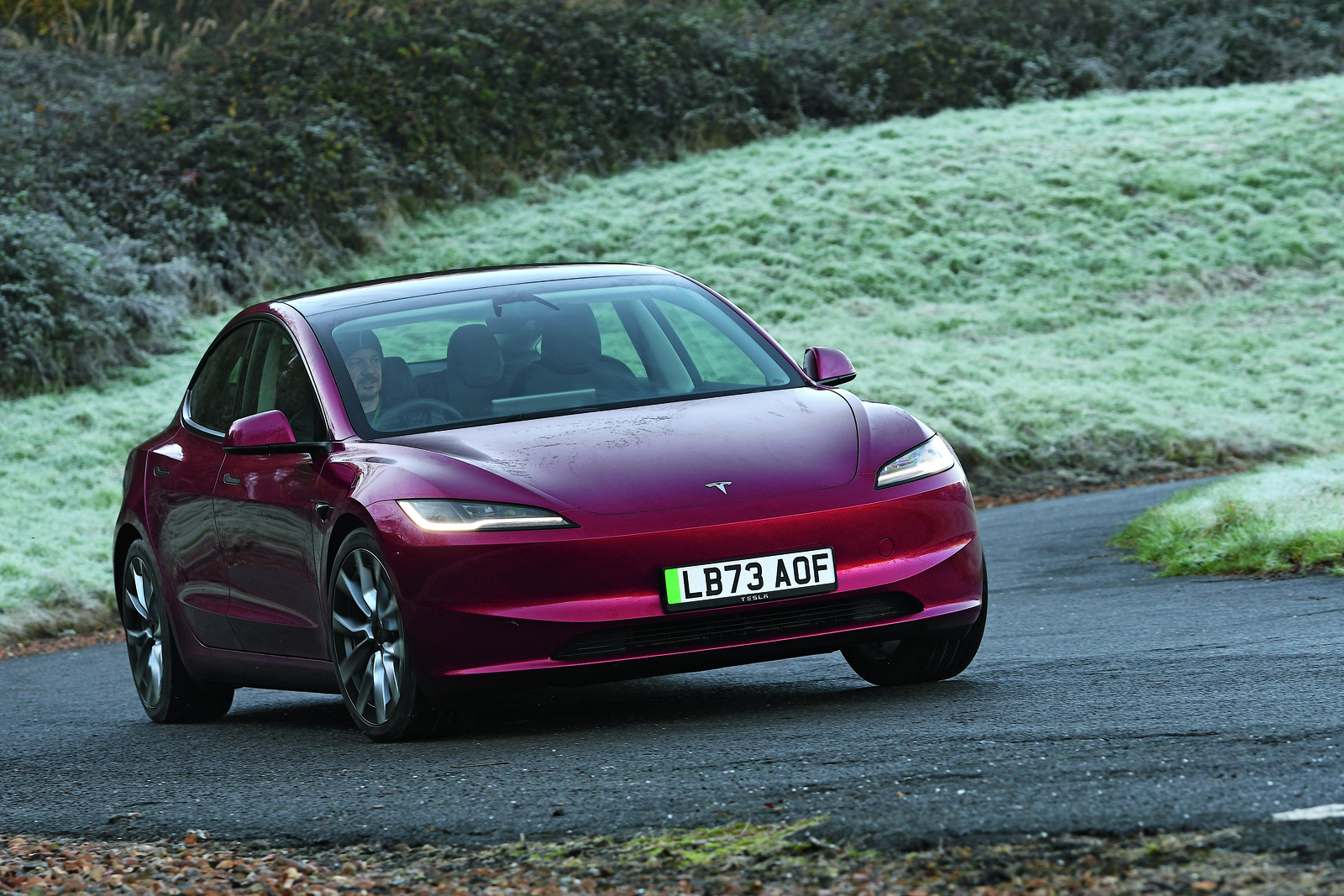 Pros Excellent performanceGreat range Cons Unsettled ride qualityFrustrating interior functions
Pros Excellent performanceGreat range Cons Unsettled ride qualityFrustrating interior functions
Best for: all-round ability
The Tesla Model 3 is still as hugely significant for the EV brand as it has ever been, helping to spearhead its continued charge in Europe.
A great all-rounder, the Model 3 received a mid-life facelift in 2024, bringing with it a sharp design refresh, plus interior and technology updates.
Sensitive, direct steering is a huge draw for the Model 3, and it’s fun and engaging in most driving situations. A 0-60mph sprint of 4.4sec is rapid, and few EVs will match it for the same price.
Refinement and ride were weak points in the old Model 3, but this one improves things slightly. It’s still not as comfortable as it should be, but it’s far quieter than before.
Range has increased too. While the previous Model 3 offered 254 miles in its entry-level specification, the latest car produces 344 miles. The long-range model comes with 391 miles, which is far ahead of several rivals.
Prices start from £39,990, which remains competitive in a market that is increasing in size year-on-year.
Read our Tesla Model 3 review
Save money on a new Tesla Model 3 with WhatCar?
Finance this car with Drivenfi
7. Mercedes-Benz EQS
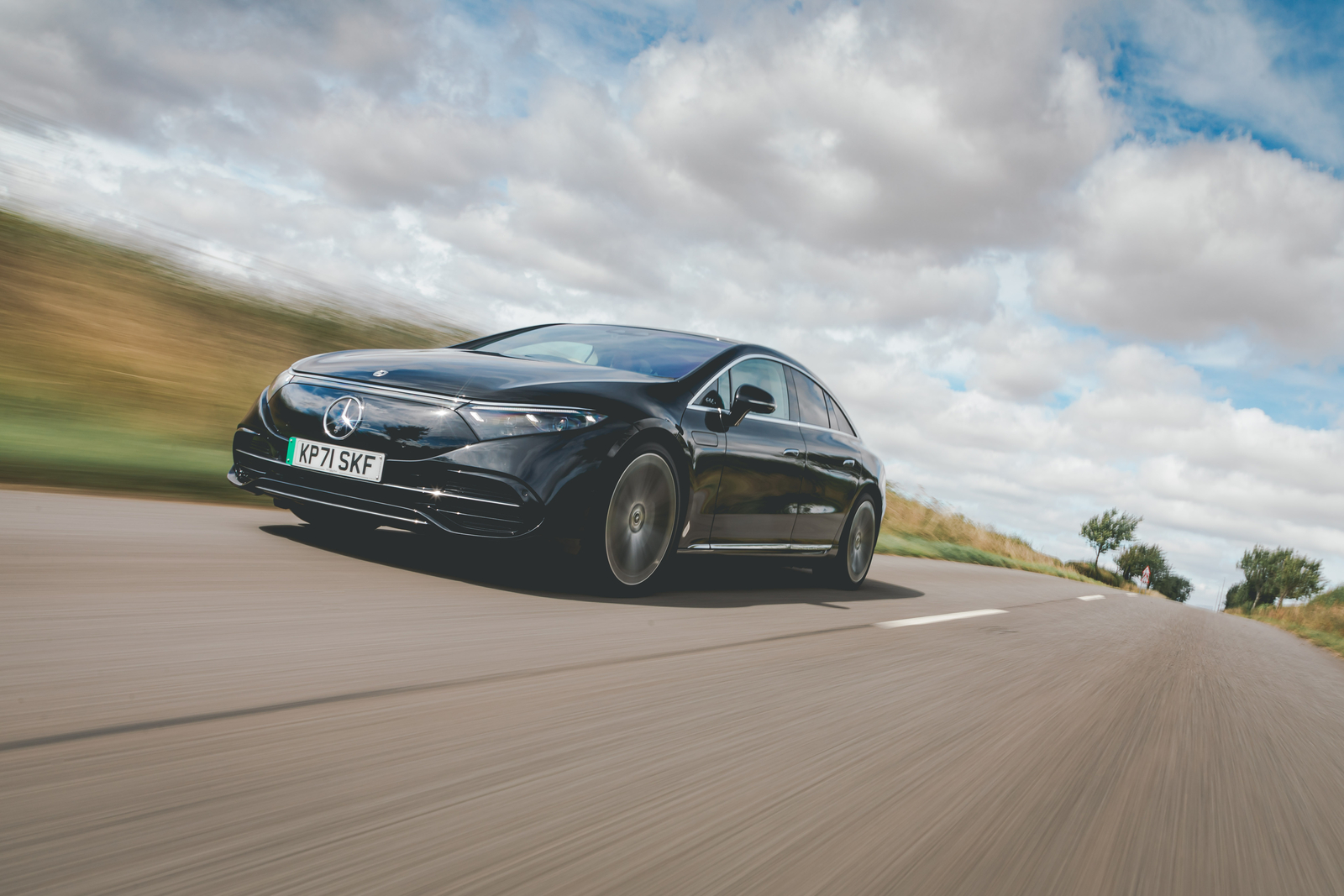 Pros Hyperscreen is hugeMassive 441-mile rangeGreat overtaking ability Cons Questionable interior qualityClaustrophobic-feeling cabinHyperscreen isn’t for everyone
Pros Hyperscreen is hugeMassive 441-mile rangeGreat overtaking ability Cons Questionable interior qualityClaustrophobic-feeling cabinHyperscreen isn’t for everyone
Best for: on-board technology
It was Tesla that blew the lid off in-car digital technology when it introduced the Model S saloon, but now the world’s oldest car maker has taken the game on in a bid to prove that it can better anything that can be made in Silicon Valley.
When the Mercedes-Benz EQS arrived in 2021, it blooded the Hyperscreen: a wide expanse of touchscreen digital real estate that seemed to occupy the entirety of the dashboard.
In reality, it doesn’t quite do that, but it does bring together a sizeable digital instrument console with a large head-up display, a huge 17.7in infotainment touchscreen and a 12.3in touchscreen in front of the passenger.
The combined effect is pretty dizzying, assuming that you like lots of touchscreen technology in cars (here at Autocar, the jury is still split on that one).
Mercedes isn’t just throwing massive screens at its cars, though. Its latest, third-generation MBUX infotainment software is much easier to navigate than its predecessors were and evidences a user-friendliness that other brands aren’t equalling, making it one of the finest luxury electric cars for sale.
Read our Mercedes-Benz EQS review
Save money on a new Mercedes EQS with WhatCar?
Finance this car with Drivenfi
8. Mercedes-Benz EQS SUV
![]() Pros Remarkable comfortImpressive refinement Big battery Cons Interior doesn’t match the car’s priceBrakes don’t provide much confidenceVery heavy
Pros Remarkable comfortImpressive refinement Big battery Cons Interior doesn’t match the car’s priceBrakes don’t provide much confidenceVery heavy
Best for: ride comfort
On-board comfort was a character facet of new cars overlooked for much of the late 20th century, but it’s now making something of a resurgence with EVs.
A gentle, absorptive, quiet ride is a dynamic quality that you can enjoy on every journey, and while we just somehow expect EVs to have one because of their wider refinement advantages, we don’t always get it.
So if you want to prioritise a comfortable ride, the Mercedes EQS SUV is the big EV to go for. The high-rise seven-seater rides with almost no perceptible road noise at all and makes lumps and bumps seem to just disappear under its wheels. As far as comfort is concerned, it simply doesn’t get much better than this.
For a great-riding EV of a different shape or price point, meanwhile, look to the Hyundai Ioniq 5 or the excellent BMW i7 limousine.
Read our Mercedes-Benz EQS SUV review
Save money on a new Mercedes EQS SUV with WhatCar?
Finance this car with Drivenfi
9. MG 4 EV
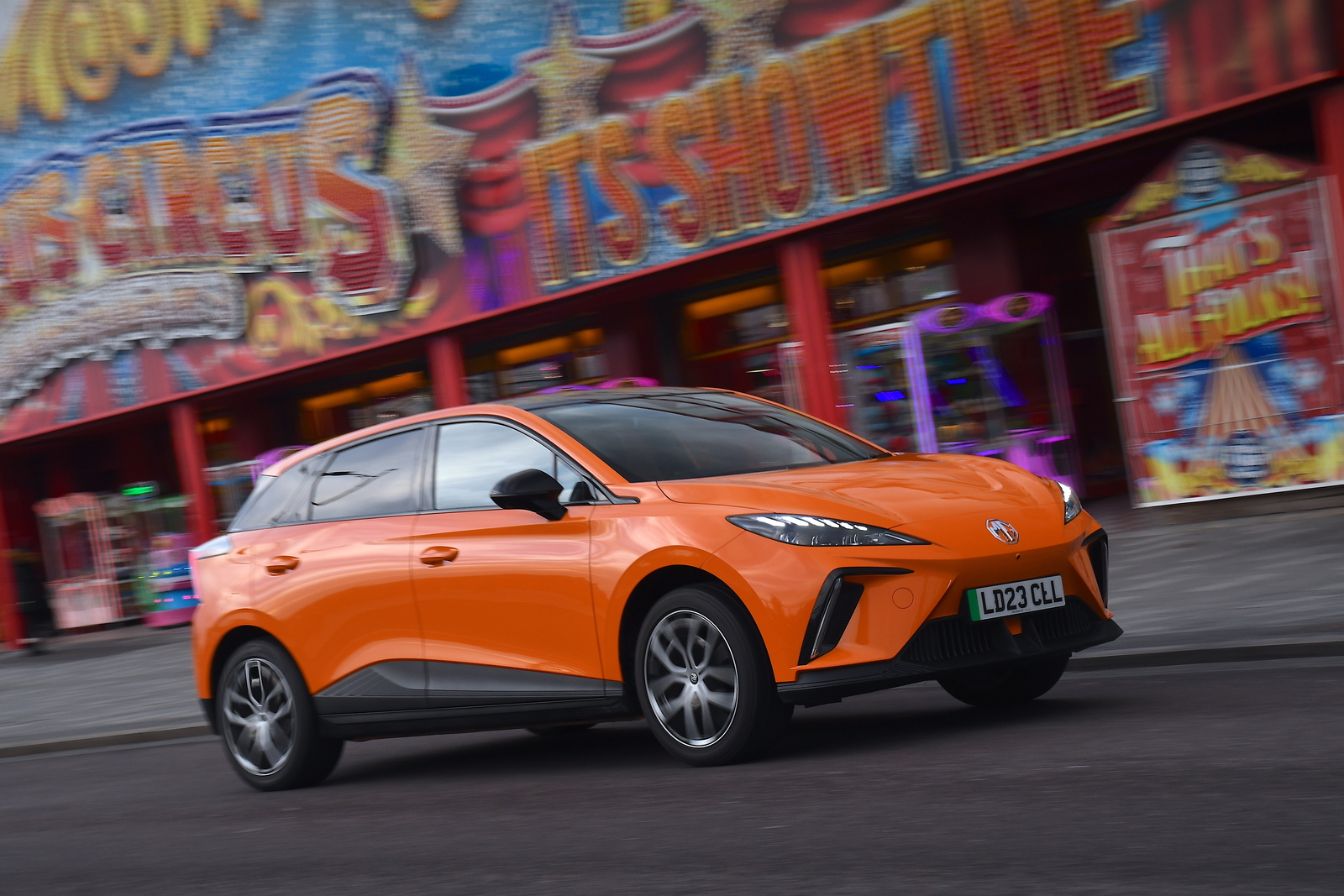 Pros Priced on a par with VW GolfGreat to driveSurprisingly practical Cons Interior materials feel flimsyFrustrating driver assistance systems
Pros Priced on a par with VW GolfGreat to driveSurprisingly practical Cons Interior materials feel flimsyFrustrating driver assistance systems
Best for: value for money
If you asked the average Brit on the street why they don’t already own an electric car, what response would you get? “Because they cost too much and they don’t go far enough between charges.” Well, think again.
Built in Ningde, China, by SAIC and presented to UK buyers wrapped in the comfort blanket of a brand they know well, the MG 4 offers a choice of 51kWh, 64kWh and 77kWh battery packs.
The smallest of those can be had for a whisker under £27,000 (which now only just about buys the cheapest combustion-engined Volkswagen Golf) and is rated for 218 miles between charges. The biggest, meanwhile, is rated for 323 miles yet still costs less than the cheapest plug-in hybrid Vauxhall Astra.
Value isn’t the only thing the 4 has on its side. It also has a pleasingly well-balanced, rear-driven chassis and driving dynamics that feel much more finely honed than you’d expect.
A roomy four-seat cabin completes a package that only the foolish wouldn’t make time to at least sample.
Read our MG 4 EV review
Save money on a new MG 4 with WhatCar?
Finance this car with Drivenfi
10. Volkswagen ID Buzz
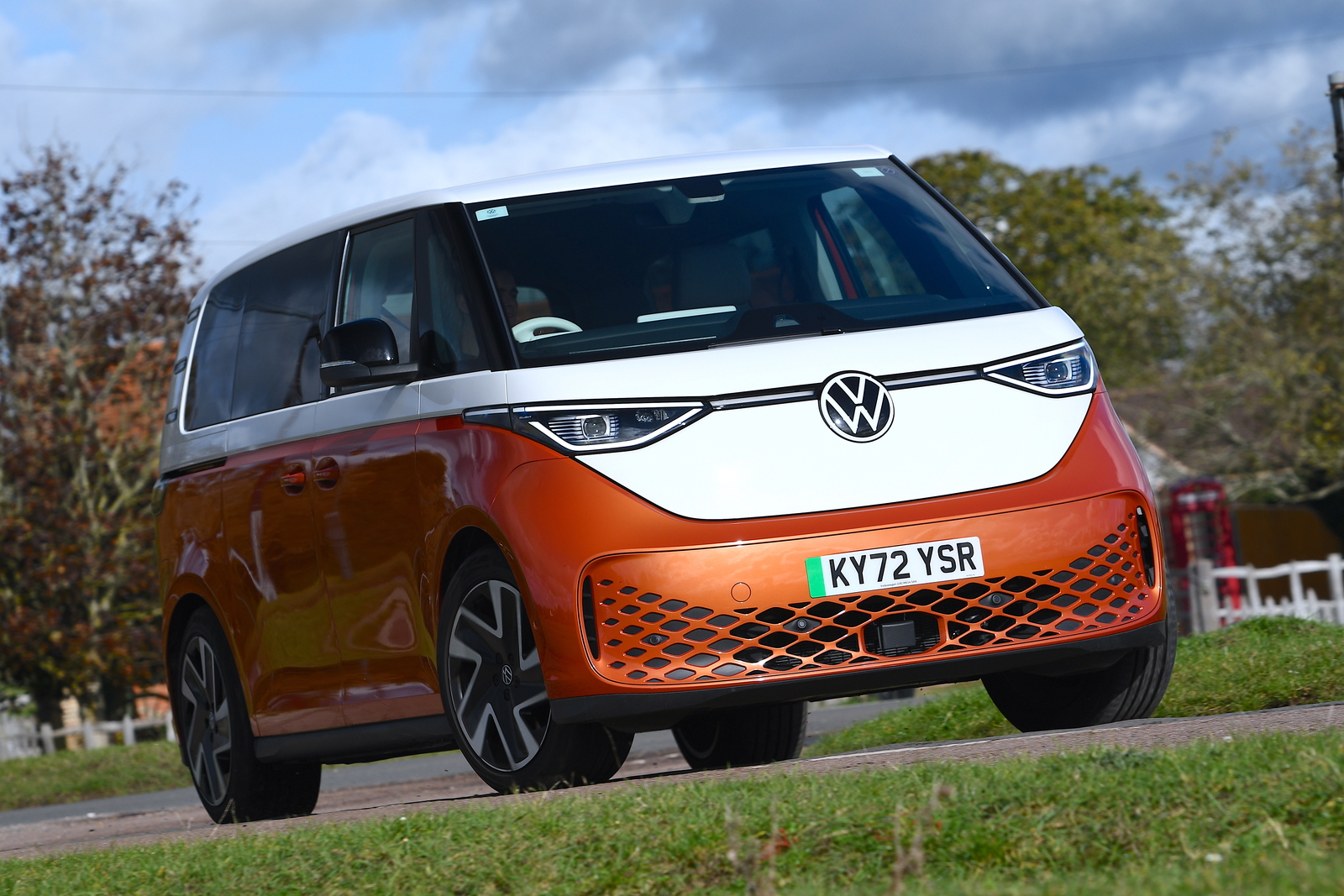 Pros Hugely practicalRefined Cons High priceNo seven-seat option
Pros Hugely practicalRefined Cons High priceNo seven-seat option
Best for: practicality
Volkswagen finally got around to rebooting its iconic Type 2 ‘microbus’ with the ID Buzz.
Sized to sit between a big car and a medium-sized van, it’s intended to fit into typical parking bays and to be easy enough to drive and use in everyday traffic. To feel like a regular family car on the outside but provide much more space and versatility inside, basically.
The Buzz offers passenger and cargo space well in advance of even bigger luxury EVs – and the long-wheelbase version adds seven-seat versatility and extra carrying capacity on the top.
Volkswagen’s retro design makes the MPV more desirable than any other utility-flavoured EV, and there are four-wheel-drive, camper van and GTX performance versions planned.
The Buzz is a super-practical EV that you will want to own, that’s designed for life and that escapes the drawbacks of the usual van conversions.
Read our Volkswagen ID Buzz review
Save money on a new Volkswagen ID Buzz with WhatCar?
Finance this car with Drivenfi

